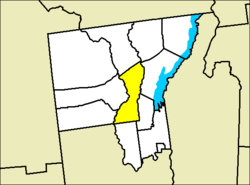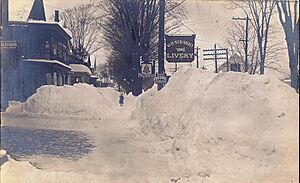Warrensburg, New York facts for kids
Quick facts for kids
Warrensburg
|
|
|---|---|

Location of Warrensburg in Warren County
|
|
| Country | United States |
| State | New York |
| County | Warren |
| Established | 1813 |
| Area | |
| • Total | 64.80 sq mi (167.83 km2) |
| • Land | 63.49 sq mi (164.43 km2) |
| • Water | 1.31 sq mi (3.40 km2) |
| Population
(2020)
|
|
| • Total | 3,959 |
| • Density | 61.096/sq mi (23.589/km2) |
| Time zone | UTC-5 (EST) |
| • Summer (DST) | UTC-4 (DST) |
| ZIP code(s) |
12885
|
| Area code(s) | 518 |
| FIPS code | 36-113-78300 |
| Website | www.townofwarrensburg.org |
Warrensburg is a small town in Warren County, New York. It is located in the middle of the county, just west of Lake George. Warrensburg is part of the larger Glens Falls metropolitan area. In 2020, about 3,959 people lived there.
The county is named after General Joseph Warren. However, the town of Warrensburg is named after James Warren. He was an important person who settled in the area a long time ago. U.S. Route 9 goes through the town. Interstate 87 (also called the Northway) is right next to it.
The main part of Warrensburg is called a "hamlet." It is also known as a census-designated place (CDP). This hamlet is much smaller than the whole town. But, it has about 75% of the town's people living in it. The hamlet includes many historic places. These include the Hamlet of Warrensburgh Historic District and the Warrensburg Mills Historic District.
Contents
History of Warrensburg
Early Settlement
People from Western countries first settled in Warrensburg in 1786. William Bond was one of the first to live near what is now Echo Lake. We don't know much about the native peoples who lived here before. This is because there haven't been many archeological digs. But, we do know that the Six Nations were active in the areas around Warrensburg. This was during the 1600s and 1700s.
Town's Beginning
On April 4, 1813, the community leaders had their first town meeting. They met in a private home. They chose James L. Thurman as the town's first supervisor. They also elected other officials and workers. Before it became a town, the area was called "The Bridge." This was because it was close to a bridge over the Schroon River.
Famous Visitors
Some local stories say that James Fenimore Cooper wrote his famous book, The Last of the Mohicans, in Warrensburg. They say he wrote it in an apartment on Main Street. But, it's more likely that he only visited the town for a short time while working on the book.
Adirondack Park
In 1894, a new rule was added to the New York State Constitution. This rule made Warrensburg part of the Adirondack Park. This park is a state forest preserve. It is meant to be kept "forever wild."
Local Businesses and Floods
In 1961, workers at the Warrensburg Board & Paper Corporation voted to join a union. The union helped them get better benefits. These included an insurance plan and wage increases. In 1974, a fire partly destroyed the paper mill.
In 1976, the Schroon River flooded because of melting snow. The water rose very high around the paper mill. It caused pollution and damaged buildings. To help the flooding, a ditch was dug. This caused some land to wash away near the dam.
World's Largest Garage Sale
Since 1979, the Warrensburg Chamber of Commerce has hosted a special event. It's called the "World's Largest Garage Sale." During this event, people from the town and other sellers set up a huge garage sale. It covers the whole town!
Geography
Warrensburg covers about 64.8 square miles (167.8 square kilometers). Most of this area is land. About 1.1 square miles (3.4 square kilometers) is water.
The Hudson River forms the western border of the town. The Schroon River flows into the Hudson River near the western town line.
Population and People
In 2020, the population of Warrensburg was 3,959 people.
In 2000, there were 4,255 people living in the town. There were 1,718 households. About 32.8% of these households had children under 18. The average household had 2.44 people.
The median age in the town was 38 years old. About 24.9% of the people were under 18. About 13.7% were 65 or older.
Communities and Places
- Forest Lake Camp for Boys and Girls - This is a traditional summer camp for boys and girls. It is located on the border between Warrensburg and Chestertown. It has been around since 1926.
- Camp Echo Lake - This is another traditional summer camp for boys and girls in Warrensburg. It started in 1946.
- Riverbank – This is a small community (hamlet) in the northeast part of the town.
- Warrensburg – This is the main hamlet of Warrensburg. It is located near the eastern town line on Route 9. It is the biggest community in the town.
- Warrensburg Mills Historic District - This area was created in 1975 to protect its history. It includes 220 properties over 40 acres of land. It is located along the Schroon River.
- Sinai Retreats - This is a Jewish educational retreat. It was started in 1978. It is located on a 100-acre campus near the Schroon River and the Hudson River.
Notable People from Warrensburg
- Floyd Bennett – A famous aviator who was one of the first to fly to the North Pole. He received the Medal of Honor.
- Charles Reed Bishop – He was a Minister of Foreign Affairs for the Kingdom of Hawaii.
- Louis W. Emerson – He was a member of the U.S. House of Representatives from 1899 to 1903.
- Daniel P. Sheehan – A lawyer who worked on important public interest cases. He is also a public speaker and educator.
Images for kids
See also
 In Spanish: Warrensburg (Nueva York) para niños
In Spanish: Warrensburg (Nueva York) para niños




